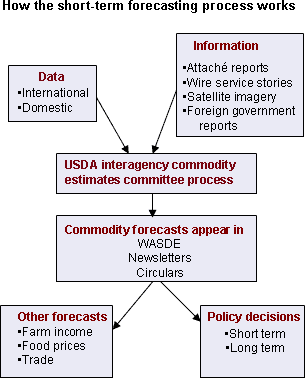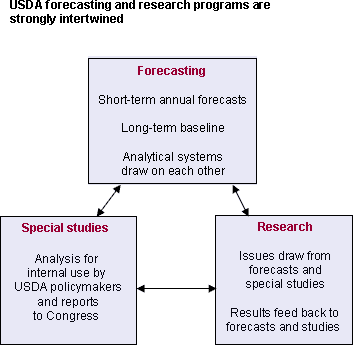
USDA Outlook Process
USDA Short-Term Annual Supply and Demand Projections Provide a Benchmark
Each month, the U.S. Department of Agriculture (USDA) publishes annual supply and demand forecasts for major crop and livestock commodities for the nation and the world. These forecasts appear in USDA's World Agricultural Supply and Demand Estimates (WASDE).
ERS analysts—as well as those from other agencies—have an important role in conducting research and analyses that help shape the WASDE forecasts which are used as benchmarks in the marketplace because of their comprehensive nature, objectivity, and timeliness.
Annual forecasts appear monthly in WASDE for the following:
- Crops (U.S. and world)—wheat, rice, feed grains (corn, sorghum, barley, oats), soybeans, cotton, and sugar.
- Livestock (U.S. only)—meat animals, poultry, and dairy.
By defining the fundamental conditions in commodity markets, these forecasts affect decisions made by farmers and ranchers, other businesses, and governments.
Interagency Committees Coordinate Agricultural Commodity Projections
Several USDA agencies contribute to development of the projections appearing in WASDE, including the Agricultural Marketing Service (AMS), Economic Research Service (ERS), Foreign Agricultural Service (FAS), and Farm Service Agency (FSA).
The World Agricultural Outlook Board (WAOB) coordinates the process, chairs the interagency committees for each commodity, and issues the WASDE report.
The National Agricultural Statistics Service (NASS) does not participate in the interagency committees, but provides most of the U.S. crop production forecasts and data for livestock production forecasts. NASS also provides monthly and historical prices and other data.
How the Short-Term Forecasting Process Works
The process combines data and information. Analysts use survey results from NASS, market news reports from AMS, trade data from the Department of Commerce, foreign attaché reports and satellite imagery from FAS, recent weather information analyzed by WAOB meteorologists, program information and data from FSA, and other commodity-specific sources.

The monthly projections process combines the following:
- Data—Results of producer and industry surveys conducted by NASS, AMS, and other agencies.
- Economic models and statistical analysis—Analysis conducted by agencies regarding all aspects of the commodity supply and demand balance sheet.
- Expert judgment—Domestic and international context and experience brought to the process.
Projections are developed during a 2-week, consensus-based process that produces the WASDE report. WASDE is generally released between the 8th and 12th of the month at noon Eastern Time.
ERS releases outlook reports and FAS issues commodity circulars shortly after WASDE. They provide additional data and key insights into the factors shaping markets. ERS analysts also develop supply, demand, and price forecasts for commodities not included in the WASDE projections (fruits and vegetables) in coordination with the World Agricultural Outlook Board (WAOB).
ERS publishes the following outlook report series:
- Cotton and Wool
- Feed
- Fruit and Tree Nuts
- Livestock, Dairy, and Poultry
- Oil Crops
- Rice
- Sugar and Sweeteners
- Vegetables and Pulses
- Wheat
- And Special Reports
Supply and demand projections developed during the interagency process play a key role in developing farm-income and food-price forecasts, and are frequently used as a starting point for analysis supporting short- and long-term policy decisions.
USDA Also Develops 10-Year Agricultural Baseline Projections
The baseline projections are prepared using an interagency process similar to that used for short-term projections. The projections are reviewed and cleared by an interagency committee that is chaired by the WAOB. ERS has the lead role in preparing the annual baseline report. These 10-year supply, demand, and price projections are for major commodities and countries, and are based on…
- Specific assumptions, including normal U.S. and global weather, the continuation of U.S. policies based on current law, and a specific global and U.S. macroeconomic scenario.
- A composite of model results and judgmental analysis.
In addition to major crop and livestock commodities, the baseline also includes projections for fruits, vegetables, and tobacco. The baseline also contains projections for farm income, food prices, and the value of U.S. agricultural trade.
The baseline projections are published annually in February, after the President's Budget is issued. They are used for the preparation of the President's Budget and as a benchmark from which to conduct policy analysis (for example, on the expected impacts of greater trade liberalization on the agricultural sector).
ERS's Forecasting and Research Programs are Strongly Intertwined
Long-term research at ERS produces critical information that helps shape our knowledge of markets, how they operate, and how they are changing. The outlook program helps ERS focus on key issues facing policymakers, farmers, and industry.


